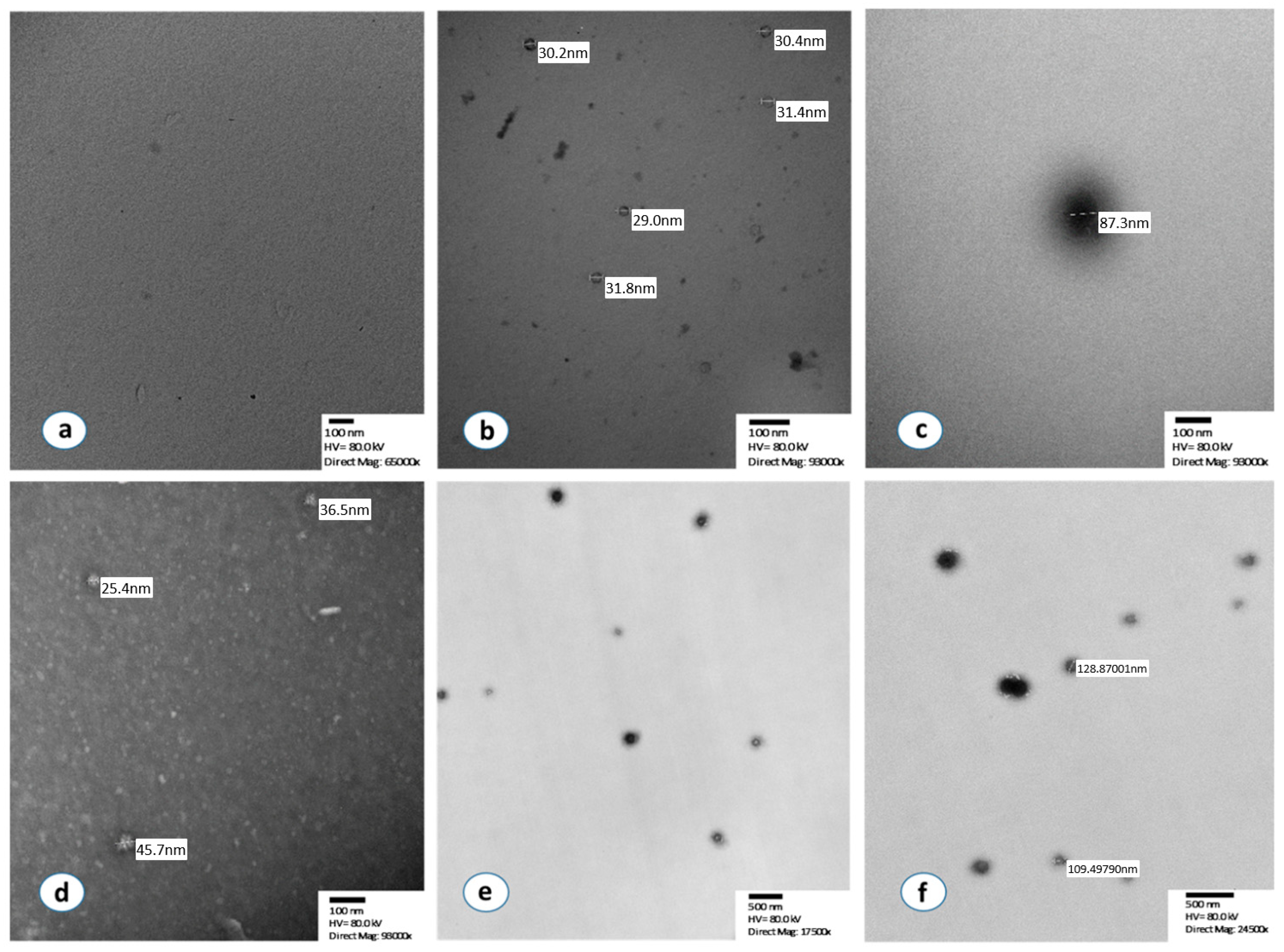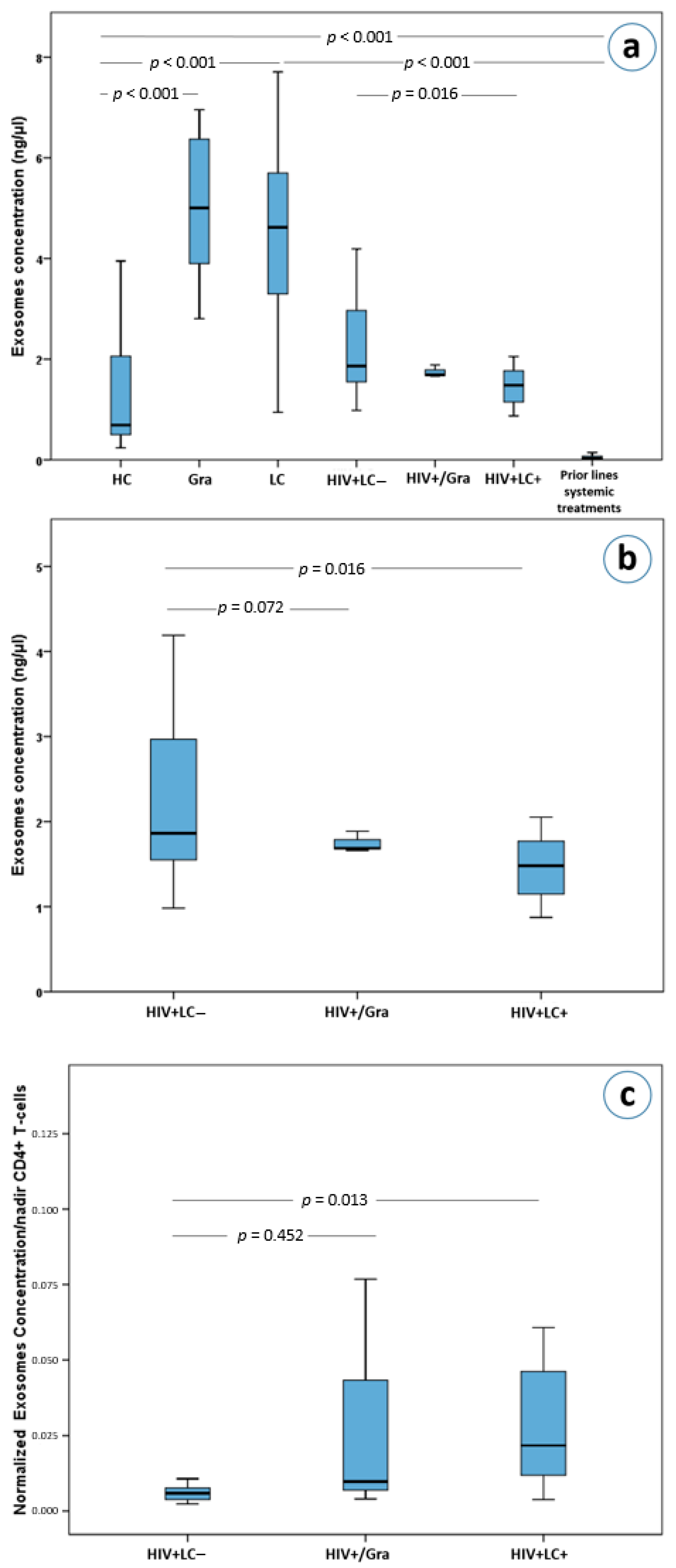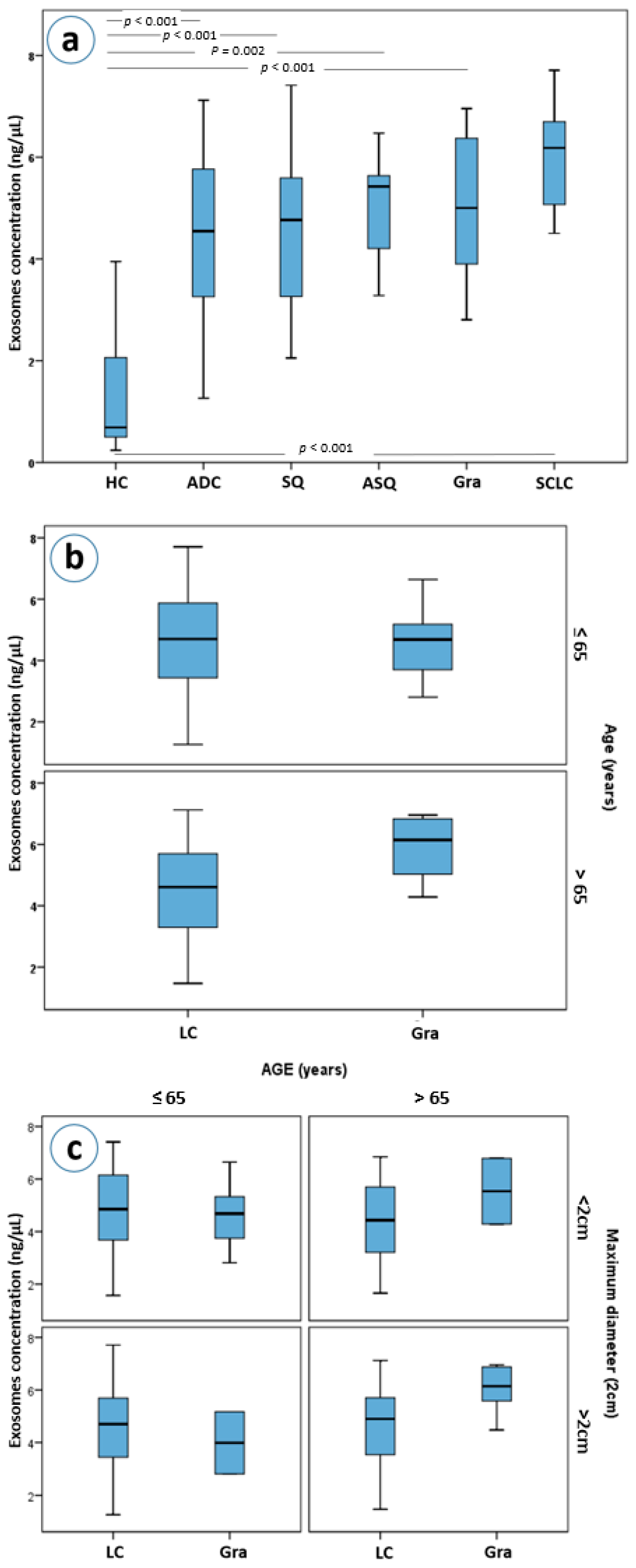Clinical Significance of Plasma CD9-Positive Exosomes in HIV Seronegative and Seropositive Lung Cancer Patients
Abstract
:Simple Summary
Abstract
1. Introduction
2. Materials and Methods
2.1. Study Design, Population and Data Collection
2.2. Collection of Plasma Samples, Exosomes Isolation, and Quantification
2.3. Verification of Isolated Plasma Exosomes
2.4. Statistical Analysis
3. Results
3.1. Verification of Isolated Exosomes
3.2. Plasma Exosome Concentrations Differ among Subpopulations
3.3. Normalized Exosomes Were Higher in HIV+/LC+ Patients
3.4. Plasma Exosomes, Disease Stage, and Gender
3.5. Small Cell Carcinomas Have Higher Concentrations of Plasma Exosomes Than NSCLC
3.6. Granulomas vs. Lung Cancer
3.7. Concentration of Plasma Exosomes Is Strongly Associated with Overall Survival (OS)
3.8. No Association with Age, BMI, Maximum Diameter, Vessel Infiltration, Recurrence, Smoking Status, Grade and Race
4. Discussion
5. Conclusions
Author Contributions
Funding
Institutional Review Board Statement
Informed Consent Statement
Data Availability Statement
Conflicts of Interest
References
- Reck, M.; Rabe, K.F. Precision diagnosis and treatment for advanced non-small-cell lung cancer. N. Engl. J. Med. 2017, 377, 849–861. [Google Scholar] [CrossRef] [PubMed] [Green Version]
- Kalemkerian, G.P.; Narula, N.; Kennedy, E.B.; Biermann, W.A.; Donington, J.; Leighl, N.B.; Lew, M.; Pantelas, J.; Ramalingam, S.S.; Reck, M.; et al. Molecular testing guideline for the selection of patients with lung cancer for treatment with targeted tyrosine kinase inhibitors: American society of clinical oncology endorsement of the college of american pathologists/international association for the study of lung cancer/association for molecular pathology clinical practice guideline update. J. Clin. Oncol. Off. J. Am. Soc. Clin. Oncol. 2018, 36, 911–919. [Google Scholar]
- Masaoutis, C.; Mihailidou, C.; Tsourouflis, G.; Theocharis, S. Exosomes in lung cancer diagnosis and treatment. From the translating research into future clinical practice. Biochimie 2018, 151, 27–36. [Google Scholar] [CrossRef]
- Kalluri, R. The biology and function of exosomes in cancer. J. Clin. Investig. 2016, 126, 1208–1215. [Google Scholar] [CrossRef]
- Sun, W.; Luo, J.D.; Jiang, H.; Duan, D.D. Tumor exosomes: A double-edged sword in cancer therapy. Acta Pharmacol. Sin. 2018, 39, 534–541. [Google Scholar] [CrossRef] [Green Version]
- Cui, S.; Cheng, Z.; Qin, W.; Jiang, L. Exosomes as a liquid biopsy for lung cancer. Lung Cancer 2018, 116, 46–54. [Google Scholar] [CrossRef]
- Kitamura, T.; Qian, B.Z.; Pollard, J.W. Immune cell promotion of metastasis. Nat. Rev. Immunol. 2015, 15, 73–86. [Google Scholar] [CrossRef]
- Dias, M.V.S.; Costa, C.S.; da Silva, L.L.P. The ambiguous roles of extracellular vesicles in hiv replication and pathogenesis. Front. Microbiol. 2018, 9, 2411. [Google Scholar] [CrossRef] [Green Version]
- Chen, L.; Feng, Z.; Yue, H.; Bazdar, D.; Mbonye, U.; Zender, C.; Harding, C.V.; Bruggeman, L.; Karn, J.; Sieg, S.F.; et al. Exosomes derived from hiv-1-infected cells promote growth and progression of cancer via hiv tar rna. Nat. Commun. 2018, 9, 4585. [Google Scholar] [CrossRef] [PubMed] [Green Version]
- Arenaccio, C.; Chiozzini, C.; Columba-Cabezas, S.; Manfredi, F.; Affabris, E.; Baur, A.; Federico, M. Exosomes from human immunodeficiency virus type 1 (hiv-1)-infected cells license quiescent cd4+ t lymphocytes to replicate hiv-1 through a nef- and adam17-dependent mechanism. J. Virol. 2014, 88, 11529–11539. [Google Scholar] [CrossRef] [PubMed] [Green Version]
- Kulkarni, R.; Prasad, A. Exosomes derived from hiv-1 infected dcs mediate viral trans-infection via fibronectin and galectin-3. Sci. Rep. 2017, 7, 14787. [Google Scholar] [CrossRef] [Green Version]
- Sampey, G.C.; Saifuddin, M.; Schwab, A.; Barclay, R.; Punya, S.; Chung, M.C.; Hakami, R.M.; Zadeh, M.A.; Lepene, B.; Klase, Z.A.; et al. Exosomes from hiv-1-infected cells stimulate production of pro-inflammatory cytokines through trans-activating response (tar) rna. J. Biol. Chem. 2016, 291, 1251–1266. [Google Scholar] [CrossRef] [Green Version]
- Hildreth, J.E.K. Hiv as trojan exosome: Immunological paradox explained? Front. Immunol. 2017, 8, 1715. [Google Scholar] [CrossRef] [PubMed] [Green Version]
- Madison, M.N.; Roller, R.J.; Okeoma, C.M. Human semen contains exosomes with potent anti-hiv-1 activity. Retrovirology 2014, 11, 102. [Google Scholar] [CrossRef] [PubMed] [Green Version]
- Barclay, R.A.; Schwab, A.; DeMarino, C.; Akpamagbo, Y.; Lepene, B.; Kassaye, S.; Iordanskiy, S.; Kashanchi, F. Exosomes from uninfected cells activate transcription of latent hiv-1. J. Biol. Chem. 2017, 292, 11682–11701. [Google Scholar] [CrossRef] [Green Version]
- Sims, B.; Farrow, A.L.; Williams, S.D.; Bansal, A.; Krendelchtchikov, A.; Matthews, Q.L. Tetraspanin blockage reduces exosome-mediated hiv-1 entry. Arch. Virol. 2018, 163, 1683–1689. [Google Scholar] [CrossRef] [Green Version]
- Chettimada, S.; Lorenz, D.R.; Misra, V.; Dillon, S.T.; Reeves, R.K.; Manickam, C.; Morgello, S.; Kirk, G.D.; Mehta, S.H.; Gabuzda, D. Exosome markers associated with immune activation and oxidative stress in hiv patients on antiretroviral therapy. Sci. Rep. 2018, 8, 7227. [Google Scholar] [CrossRef]
- Kottorou, A.E.; Antonacopoulou, A.G.; Dimitrakopoulos, F.D.; Diamantopoulou, G.; Sirinian, C.; Kalofonou, M.; Theodorakopoulos, T.; Oikonomou, C.; Katsakoulis, E.C.; Koutras, A.; et al. Deregulation of methylation of transcribed-ultra conserved regions in colorectal cancer and their value for detection of adenomas and adenocarcinomas. Oncotarget 2018, 9, 21411–21428. [Google Scholar] [CrossRef] [Green Version]
- Edge, S.; Byrd, D.R.; Compton, C.C.; Fritz, A.G.; Greene, F.; Trotti, A. (Eds.) Ajcc Cancer Staging Handbook, 7th ed.; Springer: New York, NY, USA, 2010. [Google Scholar]
- Camp, R.L.; Dolled-Filhart, M.; Rimm, D.L. X-tile: A new bio-informatics tool for biomarker assessment and outcome-based cut-point optimization. Clin. Cancer Res. Off. J. Am. Assoc. Cancer Res. 2004, 10, 7252–7259. [Google Scholar] [CrossRef] [Green Version]
- Matsumoto, Y.; Kano, M.; Akutsu, Y.; Hanari, N.; Hoshino, I.; Murakami, K.; Usui, A.; Suito, H.; Takahashi, M.; Otsuka, R.; et al. Quantification of plasma exosome is a potential prognostic marker for esophageal squamous cell carcinoma. Oncol. Rep. 2016, 36, 2535–2543. [Google Scholar] [CrossRef] [PubMed] [Green Version]
- Silva, J.; Garcia, V.; Rodriguez, M.; Compte, M.; Cisneros, E.; Veguillas, P.; Garcia, J.M.; Dominguez, G.; Campos-Martin, Y.; Cuevas, J.; et al. Analysis of exosome release and its prognostic value in human colorectal cancer. Genes Chromosomes Cancer 2012, 51, 409–418. [Google Scholar] [CrossRef]
- Szajnik, M.; Derbis, M.; Lach, M.; Patalas, P.; Michalak, M.; Drzewiecka, H.; Szpurek, D.; Nowakowski, A.; Spaczynski, M.; Baranowski, W.; et al. Exosomes in plasma of patients with ovarian carcinoma: Potential biomarkers of tumor progression and response to therapy. Gynecol. Obstet. 2013, (Suppl. 4), 3. [Google Scholar] [CrossRef] [Green Version]
- Liu, Q.; Xiang, Y.; Yuan, S.; Xie, W.; Li, C.; Hu, Z.; Wu, N.; Wu, L.; Yu, Z.; Bai, L.; et al. Plasma exosome levels in non-small-cell lung cancer: Correlation with clinicopathological features and prognostic implications. Cancer Biomark. Sect. A Dis. Markers 2018, 22, 267–274. [Google Scholar] [CrossRef]
- Sandfeld-Paulsen, B.; Aggerholm-Pedersen, N.; Baek, R.; Jakobsen, K.R.; Meldgaard, P.; Folkersen, B.H.; Rasmussen, T.R.; Varming, K.; Jorgensen, M.M.; Sorensen, B.S. Exosomal proteins as prognostic biomarkers in non-small cell lung cancer. Mol. Oncol. 2016, 10, 1595–1602. [Google Scholar] [CrossRef] [Green Version]
- Hong, C.S.; Muller, L.; Whiteside, T.L.; Boyiadzis, M. Plasma exosomes as markers of therapeutic response in patients with acute myeloid leukemia. Front. Immunol. 2014, 5, 160. [Google Scholar] [CrossRef] [Green Version]
- Ludwig, S.; Floros, T.; Theodoraki, M.N.; Hong, C.S.; Jackson, E.K.; Lang, S.; Whiteside, T.L. Suppression of lymphocyte functions by plasma exosomes correlates with disease activity in patients with head and neck cancer. Clin. Cancer Res. Off. J. Am. Assoc. Cancer Res. 2017, 23, 4843–4854. [Google Scholar] [CrossRef] [PubMed] [Green Version]
- Muller, L.; Muller-Haegele, S.; Mitsuhashi, M.; Gooding, W.; Okada, H.; Whiteside, T.L. Exosomes isolated from plasma of glioma patients enrolled in a vaccination trial reflect antitumor immune activity and might predict survival. Oncoimmunology 2015, 4, e1008347. [Google Scholar] [CrossRef] [PubMed] [Green Version]
- Hubert, A.; Subra, C.; Jenabian, M.A.; Tremblay Labrecque, P.F.; Tremblay, C.; Laffont, B.; Provost, P.; Routy, J.P.; Gilbert, C. Elevated abundance, size, and microrna content of plasma extracellular vesicles in viremic hiv-1+ patients: Correlations with known markers of disease progression. J. Acquir. Immune Defic. Syndr. 2015, 70, 219–227. [Google Scholar] [CrossRef] [PubMed] [Green Version]
- Jeannin, P.; Chaze, T.; Giai Gianetto, Q.; Matondo, M.; Gout, O.; Gessain, A.; Afonso, P.V. Proteomic analysis of plasma extracellular vesicles reveals mitochondrial stress upon htlv-1 infection. Sci. Rep. 2018, 8, 5170. [Google Scholar] [CrossRef] [Green Version]
- Lenassi, M.; Cagney, G.; Liao, M.; Vaupotic, T.; Bartholomeeusen, K.; Cheng, Y.; Krogan, N.J.; Plemenitas, A.; Peterlin, B.M. Hiv nef is secreted in exosomes and triggers apoptosis in bystander cd4+ t cells. Traffic 2010, 11, 110–122. [Google Scholar] [CrossRef] [PubMed] [Green Version]
- Eitan, E.; Green, J.; Bodogai, M.; Mode, N.A.; Baek, R.; Jorgensen, M.M.; Freeman, D.W.; Witwer, K.W.; Zonderman, A.B.; Biragyn, A.; et al. Age-related changes in plasma extracellular vesicle characteristics and internalization by leukocytes. Sci. Rep. 2017, 7, 1342. [Google Scholar] [CrossRef] [PubMed] [Green Version]




| Demographic Characteristics | LC Patients n (%) | Granulomas Patients n (%) | Pre-Treated LC Patients n (%) | HIV+/LC– Patients n (%) | HIV+/Gra n (%) | HIV+/LC+ Patients n (%) | Healthy Controls n (%) |
|---|---|---|---|---|---|---|---|
| Total | 166 (100) | 20 (100) | 44 (100) | 31 (100) | 3 (100) | 19 (100) | 49 (100) |
| Age (years) Median (range) | 70 (44–90) | 62 (35–82) | 64 (46–82) | 51 (42–67) | 47 (46–49) | 54 (46–83) | 57 (36–90) |
| Gender | |||||||
| Total | 166 (100) | 20 (100) | 44 (100) | 31 (100) | 3 (100) | 19 (100) | 49 (100) |
| Male | 80 (48.2) | 11 (55.0) | 23 (52.3) | 21 (67.7) | 3 (100) | 11 (57.9) | 18 (36.7) |
| Female | 86 (51.8) | 9 (45.0) | 21 (47.7) | 10 (32.3) | - | 8 (42.1) | 31 (63.3) |
| Race | |||||||
| Total | 166 (100) | 20 (100) | 44 (100) | 31 (100) | 3 (100) | 19 (100) | 49 (100) |
| White | 120 (72.3) | 17 (85.0) | 34 (77.2) | 4 (12.9) | - | 1 (5.3) | 43 (87.8) |
| African American | 29 (17.5) | 1 (5.0) | 9 (20.5) | 27 (87.1) | 3 (100) | 17 (89.4) | 2 (4.1) |
| Asian | 4 (2.4) | 0 (0) | - | - | - | 1 (5.3) | 4 (8.1) |
| Other | 6 (3.6) | 2 (10.0) | 1 (2.3) | - | - | - | - |
| NA | 7 (4.2) | - | - | - | - | - | - |
| Smoking (pack-years) | |||||||
| Total | 166 (100) | 20 (100) | 44 (100) | 31 (100) | 3 (100) | 19 (100) | 49 (100) * |
| Cases (%) | 155 (93.4) | 20 (100) | 40 (90.9) | 25 (80.6) | 2 (66.7) | 13 (68.4) | 9 (18.4) |
| Mean (range) | 48.2 (0–240) | 21.35 (0–60) | 36.9 (0–124) | 29.76 (3–60) | 38 (6–70) | 35 (10–75) | 20.5 (5–36) |
| NA | 11 (6.6) | - | 4 (9.1) | 6 (19.4) | 1 (33.3) | 6 (31.6) | 7 (14.3) |
| Clinicopathological Characteristics | LC Patients n (%) | Granuloma Patients n (%) | Pre-Treated LC Patients n (%) | HIV+/Gra Patients n (%) | HIV+/LC+ Patients n (%) |
|---|---|---|---|---|---|
| Total | 166 (100) | 20 (100) | 44 (100) | 3 (100) | 19 (100) |
| Primary location | |||||
| Total | 166 (100) | 20 (100) | 44 (100) | 3 (100) | 19 (100) |
| Left lung | 56 (33.7) | 4 (20) | - | 2 (66.7) | 6 (31.6) |
| Right lung | 70 (42.2) | 6 (30) | - | 1 (33.3) | 12 (63.2) |
| NA | 40 (24.1) | 10 (50) | 44 (100) | - | 1 (5.3) |
| Histology | |||||
| Total | 166 (100) | 20 (100) | 44 (100) | 3 (100) | 19 (100) |
| Squamous | 58 (35.0) | - | 12 (27.3) | - | 5 (26.3) |
| Adenocarcinoma | 91 (54.8) | - | 31 (70.5) | - | 12 (63.2) |
| Adenosquamous | 8 (4.8) | - | 1 (2.3) | - | - |
| Small-cell carcinoma | 9 (5.4) | - | - | - | 2 (10.5) |
| NA | - | - | - | - | - |
| Stage | |||||
| Total | 166 (100) | 20 (100) | 44 (100) | 3 (100) | 19 (100) |
| I | 68 (41.0) | - | - | - | 9 (47.4) |
| II | 47 (28.3) | - | - | - | 4 (21) |
| III | 45 (27.1) | - | - | - | 4 (21) |
| IV | 6 (3.6) | - | 44 (100) | - | 1 (5.3) |
| NA | 0 (0.0) | - | - | - | 1 (5.3) |
| Grade | |||||
| Total | 166 (100) | 20 (100) | 44 (100) | 3 (100) | 19 (100) |
| I | 5 (3.0) | - | - | - | 1 (5.3) |
| II | 66 (39.8) | - | - | - | 2 (10.5) |
| III | 50 (30.1) | - | - | - | 4 (21.1) |
| NA | 45 (27.1) | - | 44 (100) | - | 12 (63.1) |
| Maximum diameter (cm) | |||||
| Total | 166 (100) | 20 (100) | 44 (100) | 3 (100) | 19 (100) |
| Cases (%) | 166 (100) | 20 (100) | - | 3 (100) | 17 (89.5) |
| Mean (range) | 3.36 (0.80–13.00) | 1.99 (0.50–8.00) | - | 1.3 (1.10–1.50) | 2.85 (0.90–6.00) |
| NA | - | - | 44 (100) | - | 2 (10.5) |
| Lymph node infiltration | |||||
| Total | 166 (100) | 20 (100) | 44 (100) | 3 (100) | 19 (100) |
| No | 93 (56.0) | - | - | - | 11 (57.9) |
| Yes | 71 (42.8) | - | - | - | 7 (36.8) |
| NA | 2 (1.2) | - | 44 (100) | - | 1 (5.3) |
| Survival (3 years) | |||||
| Total | 166 (100) | 20 (100) | 44 (100) | 3 (100) | 19 (100) |
| Dead | 40 (24.1) | 1(0.05) | 40 (90.9) | - | - |
| Alive | 87 (52.4) | 2 (0.1) | 4 (9.1) | - | - |
| NA | 39 (23.5) | 17 (85) | - | 3 (100) | 19 (100) |
| Survival (5 years) | |||||
| Total | 166 (100) | 20 (100) | 44 (100) | 3 (100) | 19 (100) |
| Dead | 52 (31.3) | 1 (0.05) | 43 (97.7) | - | - |
| Alive | 56 (33.7) | 1 (0.05) | 1 (3.3) | - | - |
| NA | 58 (35.0) | 18 (90) | - | 3 (100) | 19 (100) |
Publisher’s Note: MDPI stays neutral with regard to jurisdictional claims in published maps and institutional affiliations. |
© 2021 by the authors. Licensee MDPI, Basel, Switzerland. This article is an open access article distributed under the terms and conditions of the Creative Commons Attribution (CC BY) license (https://creativecommons.org/licenses/by/4.0/).
Share and Cite
Dimitrakopoulos, F.-I.; Kottorou, A.E.; Rodgers, K.; Sherwood, J.T.; Koliou, G.-A.; Lee, B.; Yang, A.; Brahmer, J.R.; Baylin, S.B.; Yang, S.C.; et al. Clinical Significance of Plasma CD9-Positive Exosomes in HIV Seronegative and Seropositive Lung Cancer Patients. Cancers 2021, 13, 5193. https://doi.org/10.3390/cancers13205193
Dimitrakopoulos F-I, Kottorou AE, Rodgers K, Sherwood JT, Koliou G-A, Lee B, Yang A, Brahmer JR, Baylin SB, Yang SC, et al. Clinical Significance of Plasma CD9-Positive Exosomes in HIV Seronegative and Seropositive Lung Cancer Patients. Cancers. 2021; 13(20):5193. https://doi.org/10.3390/cancers13205193
Chicago/Turabian StyleDimitrakopoulos, Foteinos-Ioannis, Anastasia E. Kottorou, Kristen Rodgers, John Timothy Sherwood, Georgia-Angeliki Koliou, Beverly Lee, Andrew Yang, Julie Renee Brahmer, Stephen B. Baylin, Stephen C. Yang, and et al. 2021. "Clinical Significance of Plasma CD9-Positive Exosomes in HIV Seronegative and Seropositive Lung Cancer Patients" Cancers 13, no. 20: 5193. https://doi.org/10.3390/cancers13205193
APA StyleDimitrakopoulos, F.-I., Kottorou, A. E., Rodgers, K., Sherwood, J. T., Koliou, G.-A., Lee, B., Yang, A., Brahmer, J. R., Baylin, S. B., Yang, S. C., Orita, H., Hulbert, A., & Brock, M. V. (2021). Clinical Significance of Plasma CD9-Positive Exosomes in HIV Seronegative and Seropositive Lung Cancer Patients. Cancers, 13(20), 5193. https://doi.org/10.3390/cancers13205193






